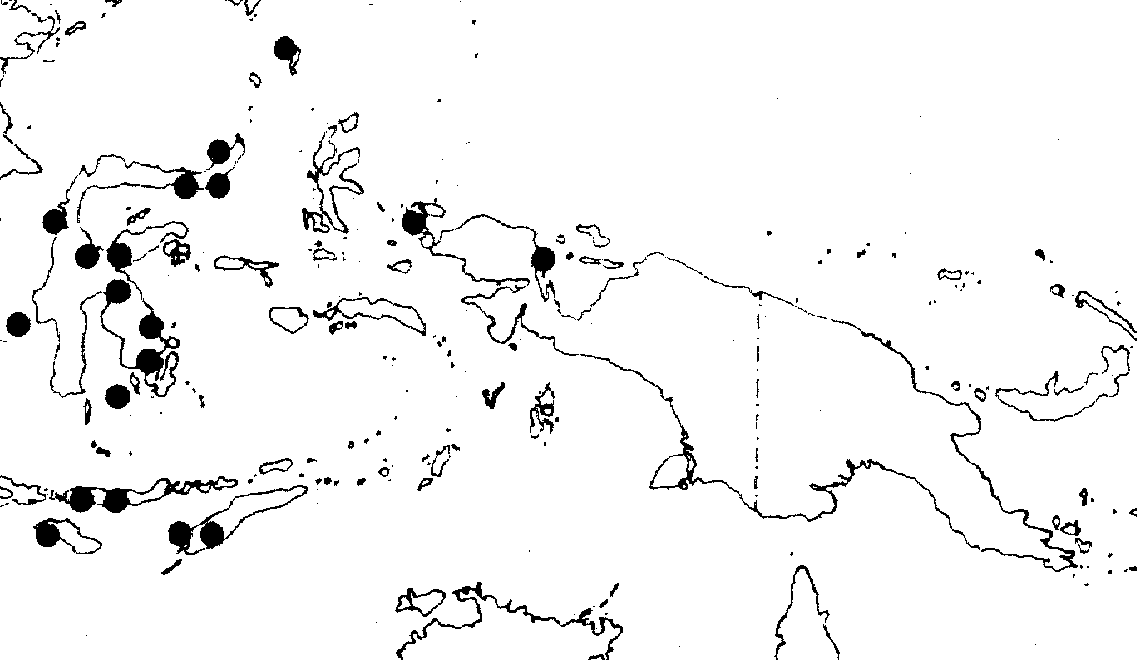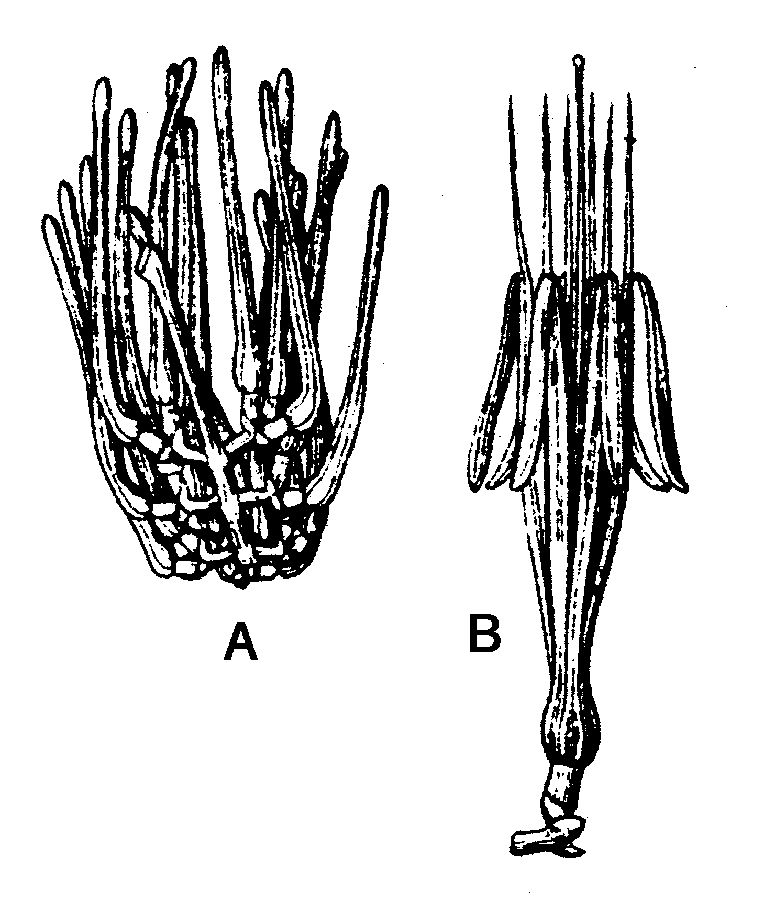
Distribution Map

Description (Barlow 1993)
Decaisnina stenopetala (Oliver) Barlow
Loranthus stenopetalus Oliver, J. Linn. Soc. 15 (1877) 99. - Decaisnina stenopetala (Oliver) Barlow, Austtal. J. Bot 22 (1974) 543. - Type: Riedel s.n. (holo K, not seen), Celebes, Manada, Gorontalo.
For description and additional synonymy see Danser, Bull. Jard. Bot. Buitenzorg III, 11 (1931) 248. The description is amended as follows: leaves usually attenuate or cuneate at the base to a petiole up to 10 mm long, not or only very slightly bifacial, thin, often drying wrinkled and fragile. Decaisnina stenopetala has few specialized characters, and thus presents a relatively generalized facies for the genus. The species can be identified by its combination of slender habit, leaves thin, drying fragile and wrinkled, with the lamina not or only very slightly bifacial, attenuate at the base to a relatively long slender petiole and attenuate to acuminate at apex, dense inflorescence bearing triads along the entire length, and corolla 22-30 mm long with the base inflated prior to anthesis. The flower colour is mostly described as red in the lower part and yellow or green above, sometimes with a dark red band at the tip.
Decaisnina stenopetala is distributed from Celebes, Moluccas, and Lesser Sunda Islands (Sumba, Timor, Flores) to the Vogelkop region of western New Guinea (Fig. 3; 37 collections seen), mostly at low elevations from sea level to 500 m but recorded up to 1400 m. Danser (1931) considered the species to be confined to Celebes and Flores, and the wider area defined in the present study is partly the result of realignment of species morphological boundaries (see below). Habitat details and hosts are poorly known, but the species apparently occurs in disturbed and primary rain forests, and has been recorded as parasitic on Aglaia, Citrus, Euodia, Euphorbia, Ficus, Gnetum, and Weinmannia.
The species is probably closely related to D. sumbawensis and D. zollingeri, with both of which it is geographically sympatric. This group of species presents considerable difficulty in taxonomic resolution. There is little variation in inflorescence and floral characters, but the strongly clustered patterns of variation in vegetative characters indicate that a number of taxa are involved. In view of the sympatry of these elements, it is concluded that they represent species which are closely related but are maintaining their integrity in nature. One of the three entities, D. sumbawensis, is distinctive in its relatively thick strongly bifacial leaves. Of the two which lack this character, D. zollingeri is distinct from D. stenopetala in its strongly angular stems and its glaucousness. The three species recognized on this basis all have high integrity with respect to geographic area and internal variation.
In resolving the species limits, a number of collections have been referred to taxa differently from their placement by Danser (1931) and Barlow (1974). In particular, specimens from western New Guinea, formerly referred by Barlow (1974) to D. stenopetala, have been found to be representative of all three species. See further notes under D. sumbawensis and D. zollingeri.
The inflation of the corolla base in D.
stenopetala is not consistently visible in the specimens examined.
The condition is presumably related to nectar presentation for
pollinators, and may be transient, developing just prior to anthesis.
When visible, the degree of expression in the specimens seen ranges
from a weak ellipsoid dilation to a globular one strongly contracted
distally.
Description (Barlow 1974)
Decaisnina stenopetala (Oliv.) Barlow, comb. nov.
Loranthus stenopetalus Oliv. J. Linn. Soc. 15: 99 (1877); Amylotheca stenopetala (Oliv.) Dans. Bull. Jard. bot. Buitenz. 10: 302 (1929); 11: 248, illus. Fig. 1, e, f (1931). For other synonymy see Danser (1931). Type-Celebes, Manado, Gorontalo, Riedel (K, not seen).
Young stems, inflorescence and calyx sparsely to moderately shortly white- or brown-tomentose, the tomentum persisting on the fruits. Young stems smooth, usually flattened and often double-edged or quadrangular below the nodes, eventually becoming terete. Petiole c. 1 cm long; lamina elliptical to ovate, usually broadest below the middle, 10-15 by 4-8 cm, thin, somewhat glaucous and dull on both sides, undulate to punctate along the veins, contracted at the base, weakly acuminate but finally acute to rounded at the apex; venation pennate, distinct on both sides. Inflorescences solitary to few in the axils; axis slender, bearing usually 5 or 6 well-spaced pairs of triads, 4-8 cm long; peduncles of the triads slender, 2-4 mm long; lateral flowers of the triads almost sessile; bracts spreading, rounded, 1 mm long. Calyx cylindrical, 2 mm long; limb erect, regularly or irregularly divided into truncate lobes, 0.7 mm long. Corolla in bud slender (not seen mature), not inflated at the base in the specimens seen, probably c. 25 mm long. Fruit small (c. 5 mm diam.), urceolate, truncate, crowned by the short persistent calyx. (Description from New Guinean materials only.)
Occurrence. West Irian; Vogelkop and Bombarai Peninsula and adjacent islands (Waigeo, Jappen, Woham) (Fig. 4), 0 to 620 m altitude. Also the Moluccas, Celebes and Lesser Sunda Islands.
Representative Specimens. WEST IRIAN: Rauki I. in Bay of Kabare, Waigeo I., c. 3 m alt., van Royen 5371, 19.i.1955 (L); Vogelkop, Isjon R. valley, Son Village, 620 malt., van Royen and Sleumer 7556, 28.x.1961 (L; CANE); Aendroea near Octa, 3 m alt., Aet (exp. Lundquist) 481, 8.vii.1941 (L; K). SCHOUTEN ISLANDS: Jappen, near Seroei, Aet and Idjan 609 (L). ARU ISLANDS: Woham, near sea level, Buwalda, 14.vi.1938.
The specimens that have been included in this entity are rather uniform, and agree closely with the descriptions of Amylotheca zollingeri by Danser (1931), and with specimens determined as such by that author. As I doubt that these two taxa are distinct species (especially after examining the New Guinean materials), I have referred the New Guinean specimens to D. stenopetala, which name has priority. The variation in stem flattening that supposedly distinguishes the two species is considerable, but probably has little taxonomic significance. Other species of Decaisnina, notably D. hollrungii, are similarly variable.
The range of D. stenopetala thus
extends from Celebes and Flores to the Moluccas and to western
West Irian. In the New Guinean material studied the inflated corolla
base characteristic of the species was not evident, but mature
corollas have so far not been seen.
Illustrations

Decaisnina stenopetala (as Amylotheca stenopetala). A - Inflorescence in bud. B - flower. From Danser (1931).
Photographs
Decaisnina stenopetala
updated 20 January 2007